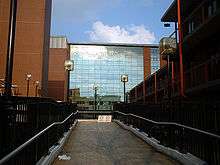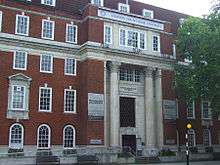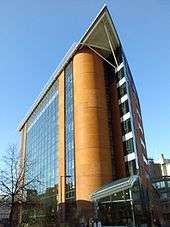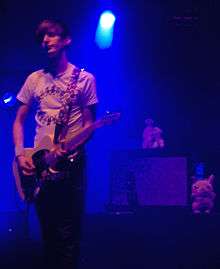London South Bank University
 | |
Former names | Borough Polytechnic Institute (1892-1970), Polytechnic of the South Bank (1970-1987), South Bank Polytechnic (1987-1992) |
|---|---|
| Type | Public |
| Established |
1992 (university status) 30 September 1892 (Borough Polytechnic Institute)[1] |
| Chancellor | Richard Farleigh[2] |
| Vice-Chancellor | David Phoenix |
Administrative staff | 1,700 |
| Students | 17,735 (2014/15)[3] |
| Undergraduates | 13,020 (2014/15)[3] |
| Postgraduates | 4,715 (2014/15)[3] |
| Location |
Southwark, London, England, United Kingdom Coordinates: 51°29′53″N 0°06′06″W / 51.49814°N 0.10154°W |
| Campus | Urban |
| Website |
www |
|
| |
London South Bank University (LSBU) is a public university in Newington, London. It has 17,735 students and 1,700 staff,[4] and is based in the London Borough of Southwark, near the South Bank of the River Thames, from which it takes its name.
Founded from charitable donations in 1892 as the "Borough Polytechnic Institute", it absorbed several other local colleges in the 1970s and 1990s, and achieved university status in 1992.[1] LSBU is a post-1992 or new university. The current Chancellor is investor Richard Farleigh and Vice-Chancellor is Prof David Phoenix.
History

1892 to 1900
LSBU was founded in 1892 as the Borough Polytechnic Institute. It has since undergone several name changes, becoming the Polytechnic of the South Bank in 1970, South Bank Polytechnic in 1987, South Bank University in 1992 and London South Bank University in 2003. The University has also merged with a number of other educational institutions.
In 1888, Edric Bayley, a local solicitor and member of the London School Board, set up the South London Polytechnics Committee whose members included the Lord Mayor of London, Archbishop of Canterbury, Lord Salisbury, Lord Rosebery and Sir Lyon Playfair. The Committee was successful in persuading the Charity Commissioners to pledge to match whatever could be raised from the public, up to the sum of £200,000 to establish polytechnics in South London. A public meeting at Mansion House kick-started the public appeal and by 1891 enough money had been raised to establish polytechnics at Battersea and at Borough Road, Southwark, now LSBU.
During 1890, the former buildings of Joseph Lancaster's British and Foreign Schools Society were purchased for the Borough Polytechnic Institute. In May that year, the South London Polytechnics Institutes Act was passed, so that by June 1891 the governing structure and general aims of the new Institute had been created. These aims were "the promotion of the industrial skills, general knowledge, health, and well-being of young men and women" and also for "instruction suitable for persons intending to emigrate". W. M. Richardson was chosen to be clerk to the Governing Body, Mr C. T. Millis was appointed as Headmaster, Miss Helen Smith was appointed Lady Superintendent and Mr Edric Bayley was appointed the first Chair of Governors.[5]
On 30 September 1892, the Borough Polytechnic Institute was officially opened by Lord Rosebery, with a remit to educate the local community in a range of practical skills. The Polytechnic was given a seal based on the Bridge House emblem of the City of London and a motto taken from Ecclesiastes — "Do it with thy Might". A gala event was held to mark the occasion which was widely reported in the press because of Lord Rosebery's speech on the banning of smoking in the new Institute. One of the speeches made included the hope that "the Polytechnic would do its share towards perfecting many a valuable gem found in the slums of London".[6]
The Polytechnic specialised in courses that reflected local trades including leather tanning, typography, metalwork, electrical engineering, laundry, baking, and boot & shoe manufacture. Instruction was also given in art, science, elocution, literature and general knowledge and the Polytechnic held public lectures by the likes of George Bernard Shaw, J. A. Hobson, Henry M. Stanley, and Ralph Vaughan Williams.[6]
On 10 October 1894, the National School of Bakery and Confectionery (later the National Bakery School) was opened with 78 pupils. In 1897, the Polytechnic was let to sightseers who wished to see the Diamond Jubilee parade for Queen Victoria.
1900 to 2000
In 1902 the Borough Road building was once again let to sightseers who wished to see the Coronation parade of King Edward VII. Through a donation from Mr Edric Bayley, the Edric Hall was built in 1908, along with the Lancaster Street extension buildings which gave the Polytechnic new bakery rooms, gymnasium, workshops and its triangular campus site.
In 1911, the Governors commissioned Roger Fry to create a set of seven murals to decorate the student dining room with the theme of "London on Holiday". These comprised:
- "Bathing" and "Football", Duncan Grant
- "The Zoo", Roger Fry
 LSBU accommodation: Dante Road
LSBU accommodation: Dante Road - "The Fair", Frederick Etchells
- "Toy Sailing Boats", Bernard Adeney
- "Punch & Judy", MacDonald Gill
- "Paddling", Albert Rothenstein
In 1931, they were sold to the Tate Gallery.
During the First World War, the Polytechnic manufactured munitions and gas masks for the war effort and ran courses for the army. After the War, the National Certificate system was taken up, engineering courses were offered to women in the 1920s and printing classes were dropped and run at Morley College. J W Bispham was elected the new Principal in 1922 when C T Millis retired and a rebuilding scheme was undertaken including a new facade for the Borough Road building. Class numbers increased to 8,682 students by 1927 and on 20 February 1930 the Duke of York officially opened the Polytechnic's new buildings. In 1933, Dr D H Ingall took over as Principal and a sports ground at Turney Road Dulwich was obtained for the Polytechnic. In 1933, farriery was dropped as it was too difficult to bring horses into the building.
During the Second World War, a third of the Polytechnic's campus was destroyed or damaged from the Blitz. Southwark was bombed seven times and its population halved by the end of the War. At the start of the War the boys and girls from the Polytechnic's Trade Schools were evacuated to Exeter. From 1940 to 1941, the Polytechnic was bombed five times but continued to provide hundred of meals a day to the homeless of Southwark during this period.
From 1945 to 1953, British painter David Bomberg taught art at the Polytechnic forming the 'Borough Group' of artists with his pupils in 1946.[7] In 1956, the Polytechnic was designated a Regional College of Technology and Dr J E Garside was installed as the new Principal until 1965, when Mr Vivian Pereira-Mendoza took over. Further extensions to the buildings were made during the 1960s with the opening of the National College Wing in 1961 and the extension buildings and Tower Block in 1969, which were officially opened by Prince Philip, Duke of Edinburgh.
In 1970, the Brixton School of Building (founded in 1904), the City of Westminster College (founded in 1918 – and not the same institution as the current City of Westminster College) and the National College of Heating, Ventilating, Refrigeration and Fan Engineering (founded in 1947) merged with the Polytechnic to become the Polytechnic of the South Bank. The new institution adopted a coat of arms designed to include two Thames barges set above a pentagon surrounded by five other pentagons. An official designation service took place the following year, at which Margaret Thatcher was the guest speaker. In 1972 the purpose-built Wandsworth Road site opened, providing space for the Polytechnic's Faculty of the Built Environment, which at the time was the biggest and most comprehensive faculty in Europe for teaching built environment subjects such as surveying, town planning, architecture and other property related professional disciplines. In 1975, the extensive London Road building was opened, providing space for expanding business courses and the library. In 1976, part of Rachel MacMillan College of Education merged with the Polytechnic along with the Battersea College of Education bringing with them sites at Manresa House, Roehampton and Manor House, Clapham Common.
In 1985 South Bank Technopark opened on London Road and in 1987 the Polytechnic changed its name again to become South Bank Polytechnic. In the same year, the British Youth Opera (BYO) was founded and made a home at the Polytechnic's Southwark campus. In 1987, Mrs Pauline Perry, Baroness Perry of Southwark was appointed Director, who oversaw the conversion of the Polytechnic into a flagship university.
In 1990, the Polytechnic was accredited for Research Degrees and in 1991 the Central Catering College at Waterloo and South West London College merged with it. In 1992, the newly created Baroness Perry (August 1991) became the University's first Vice-Chancellor.
In 1992, the Polytechnic was granted university status and accordingly changed its name to South Bank University. That year also saw the new university celebrate its centenary and adopt the marketing slogan, "the University without Ivory Towers". In 1993, Professor Gerald Bernbaum was appointed Vice-Chancellor and the Centenary Library was renamed the Perry Library. Redwood College of Health Studies and Great Ormond Street School of Nursing merged with the University in 1995, leading to the establishment of two satellite campuses teaching Health at Havering and Whipps Cross (which closed in 2011).
2000 to present
In 2001, Prof Deian Hopkin became Vice-Chancellor and the Wandsworth Road site was sold.
On 1 September 2003, the University underwent its most recent name change to become London South Bank University (LSBU)[1] and in that year officially opened the Keyworth Centre, a modern teaching facility. Professor Martin Earwicker was appointed Vice-Chancellor in 2009, the year in which another major building on their Southwark campus, the Grimshaw-designed K2, was opened to house the School of Health and Social Care and the Centre for Efficient and Renewable Energy in Buildings (CEREB).
On 1 January 2014, Professor Dave Phoenix was appointed Vice-Chancellor.[8]
In 2014 university officials removed a poster featuring the Flying Spaghetti Monster and the stand erected by the students from the South Bank Atheist Society during the Fresher's week, claiming it was "religiously offensive".[9] This action drew criticism from the British Humanist Association which claimed it amounted to "petty censorship in the name of offence".[9]
The LSBU-sponsored University Academy of Engineering South Bank opened its doors to students in September 2014.[10] The Academy – the first of its kind in the area to be sponsored by a university – specialises in providing a science, technology, engineering and maths (STEM) focused curriculum developed in response to industry demand for modern engineering skills. The purpose-built facility is in the Walworth area of Camberwell and can accommodate 150 students aged 11–19.
In November 2015, LSBU was accredited as a Living Wage employer, which pledges to pay all employees the UK Living Wage – a minimum of £9.15 per hour.[11]
Campus

The main campus populates a triangular section of roads in the Borough of Southwark, immediately north of the Elephant and Castle. London's South Bank is a short tube or bus journey away from Waterloo or London Bridge. To the north of the campus is Borough Road, where the main entrance is situated and the original building of the Borough Polytechnic Institute. To the west is London Road and to the east is Southwark Bridge Road. At the northwest corner is St George's Circus.
Schiller International University had a campus in the Technopark Building on the London South Bank University property.[12][13] In August 2011 Schiller stated that it was closing its London campus and will not start the Autumn 2011 semester there, due to stricter student visa requirements in the United Kingdom.[14]
There is a smaller satellite campus in east London: at Havering (LSBU at Havering), diagonally opposite Harold Wood station.
Organisation and academic life
The university has seven Schools, covering the areas of Applied Sciences, Arts and Creative Industries, The Built Environment and Architecture, Business, Engineering, Health and Social Care, and Law and Social Sciences.
At the end of 2009 it opened K2, a new sustainable teaching building which houses the training and demonstrating Centre for Efficient and Renewable Energy in Buildings (CEREB).[15] The building also houses skills laboratories for the University's nursing studients. Further campus developments included a new Student Centre in 2012, followed by an Enterprise Centre in 2013. In 2016 LSBU opened its new media centre, Elephant Studios at LSBU.
The British painter David Bomberg taught Art at the Borough Polytechnic between 1945 and 1954.[16] One of the university's halls of residence, David Bomberg House, carries his name and a handful of his works are on display at the University. Major paintings by Bomberg were acquired by the Tate Gallery after his death.
The university's main campus is close to many of London's major landmarks and tourist attractions on the South Bank and in easy reach of overground trains, the London Underground and many bus routes.
LSBU works in partnership with many institutions in the UK, Europe, Africa, the Americas and Asia. It currently works closely with a number of Chinese Higher Education Institutions, including Beijing Institute of Technology, Hunan University, Beijing University of Posts & Telecommunications, Northwestern Polytechnical University, National Academy of Education Administration etc. The collaborative educational programmes both at undergraduate and postgraduate levels have been running for over ten years with the Chinese partners.
LSBU is the first university sponsored by the Office of Chinese Language Council International (Hanban) to establish a Confucius Institute for Traditional Chinese Medicine in London.[17]
Students
70% of UK students at LSBU are Londoners. Students primarily come from the South London Boroughs of Southwark, Lambeth, Lewisham, Croydon and Newham. Around 12% of students from the EU and overseas, which equate to over 3,000 EU and other international students, from more than 130 different countries.[18] 56% of the student population are from ethnic minorities and over 80% of the students are classified as mature (21 or over when they start their course).[19]
Degree days
Graduates across the seven Schools meet in October at Royal Festival Hall for graduation ceremonies organised across a week.[20]
Rankings and reputation
| THE[21] (2016/17, national) | 89 | |
|---|---|---|
| THE[22] (2016/17, world) | 801+ | |
| Complete[23] (2017, national) |
115 | |
| The Guardian[24] (2017, national) |
107 | |
| Times/Sunday Times[25] (2017, national) |
120 [26] | |
The 2015 survey of Destination of Leavers in Higher Education (DLHE) concluded that London South Bank University has improved in many important areas.[27] Of the graduates who responded, over 90% recorded they were in work, further study or both. Popular career destinations for LSBU graduates included nursing, social work, teaching and architecture.
75% of graduates who responded to the survey were in a professional and/or managerial role just six months after graduating. The survey revealed that the average salary of LSBU graduates is £28,900 per year.
In November 2016, LSBU was named the Entrepreneurial University of the Year at the Times Higher Education Awards.[28][29]
The Guardian's 2017 league table of teaching excellence ranked the university 107 out of 119 British institutions.[30] The Sunday Times' league table, measuring a number of different factors including teaching quality, research quality and employment rates, ranks the University 120th.[31]
Notable alumni

- David Adjaye (Architecture)
- Frank Auerbach (Art)
- Shaun Bailey (Computer-aided Technology)
- Sue Black
- Paul Burstow
- Simone Callender
- Mel Calman (Illustration)
- Edd China
- June Clark
- Dennis Creffield (Art)
- Cliff Holden (Art)
- Jordan Kensington
- Leon Kossoff (Art)
- Don Lawrence(Illustration)
- Nick Leslau (Surveying)
- Russel Lissack (Sociology)
- Norma Major (Teaching)
- Shahid Malik (Business)
- Zacarias Moussaoui[32] (International Business)
- Sarah Mullally (Nursing)
- Bridget Prentice (Law)
- Umer Rashid
- Miles Richmond (Art)
- Joan Ryan (Sociology)
- Greg Searle
- Enoch Showunmi (Business)
- Edward Skoyles
- Phil Spencer (Estate Management)
- Kate Walsh (Product Design)
- Mike Weatherley
- Alison Williamson (Social Work)
- Louise Woodward[33] (Law)
See also
- Borough Road Gallery, opened 2012
References
- 1 2 3 "LSBU history". London South Bank University. Retrieved 2009-07-22.
- ↑ http://www.lsbu.ac.uk/about/chancellor.shtml
- 1 2 3 "2014/15 Students by HE provider, level, mode and domicile" (XLSX). Higher Education Statistics Agency. Retrieved 19 January 2016.
- ↑ "Table 0a - All students by institution, mode of study, level of study, gender and domicile 2005/06". Higher Education Statistics Agency online statistics. Archived from the original on 15 May 2007. Retrieved 2007-03-31.
- ↑ T. Geddes and M. Smith, The Origins of South Bank University.
- 1 2 F. G. Evans, ..Borough Polytechnic 1892–1969.
- ↑ "A Lasting Legacy". Connected. London South Bank University. 6: 11–13. Spring 2009. External link in
|journal=(help) - ↑ http://www.lsbu.ac.uk/about-us/governance/vice-chancellor
- 1 2 Merrill, Jamie (10 February 2014). "Free speech outcry as images of the Flying Spaghetti Monster are banned from London South Bank University for offending religious people". The Independent. Retrieved 11 February 2014.
- ↑ http://www.lsbu.ac.uk/__data/assets/pdf_file/0004/52294/annual-review.pdf
- ↑ http://www.lsbu.ac.uk/about-us/news/lsbu-living-wage
- ↑ "Getting here". London South Bank University. Retrieved on 28 August 2011.
- ↑ "London." (Image) Schiller International University. Retrieved on 28 August 2011. "LKIC - Technopark Building 90 London Road London, SE1 6LN "
- ↑ Li, Jonathan J. "Stricter Visa Rules in U.K. Put Some Colleges in Bind." The New York Times. 28 August 2011. Retrieved on 28 August 2011.
- ↑ Centre for Efficient and Renewable Energy in Buildings, London South Bank University, UK.
- ↑ "A Lasting Legacy" (PDF). Connected. London South Bank University. 6: 11–13. Spring 2009.
- ↑ "Confucius Institute of Traditional Medicine".
- ↑ Studying as an International Student, London South Bank University, UK.
- ↑ "Admission figures to LSBU".
- ↑ "University's website December 2015".
- ↑ "World University Rankings 2016-17 - United Kingdom". Times Higher Education. Retrieved 21 September 2016.
- ↑ "World University Rankings 2016-17". Times Higher Education. Retrieved 21 September 2016.
- ↑ "University League Table 2017". The Complete University Guide. Retrieved 25 April 2016.
- ↑ "University league tables 2017". The Guardian. 23 May 2013. Retrieved 23 May 2016.
- ↑ "The Times and Sunday Times University Good University Guide 2017". Times Newspapers. Retrieved 23 September 2016.
- ↑ http://www.thesundaytimes.co.uk/sto/University_Guide/
- ↑ https://www.lsbu.ac.uk/about-us/news/twenty-seven-percent-leap-number-lsbu-students-securing-graduate-level-positions
- ↑ http://www.lsbu.ac.uk/about-us/news/times-higher-education-awards-win
- ↑ http://digital.timeshighereducation.com/THEAWARDS2016/index.html
- ↑ "University guide 2017: University league table". The Guardian. London: Guardian News & Media Ltd. Retrieved 24 May 2016.
- ↑ "The Sunday Times University Guide". TLS - Times Literary Supplement. London: Times Newspapers Ltd. Retrieved 28 September 2016.
- ↑ Woodward Will Hijack suspect was South Bank student. The Guardian (2001-10-06)
- ↑ "Woodward parents arrested". BBC News. 14 May 1999.
External links
| Wikimedia Commons has media related to London South Bank University. |
